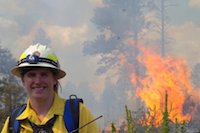Ecologist and PEEC Board member Karla Sartor is fresh off the lines of a 2-week, bilingual training in the Santa Fe National Forest focused on prescribed burning for forest health. We sat down with Karla to learn more about this fascinating topic, how she ended up in Los Alamos, and what she does as a volunteer for PEEC.
PEEC: We’re looking forward to your discussion at Nature on Tap this Thursday about prescribed burning. Why did you suggest that topic, and what do you plan to talk about?
K.S.: With proper planning, prescribed burning can go a long way toward preventing mega fires like Las Conchas, protecting communities, and improving watershed and forest health. There is a huge need for more prescribed burning, and a need for more people who are qualified to do it effectively and safely. I’ve just had the opportunity to participate in a 2-week, Spanish language Prescribed Fire Training Exchange (TREX) in the Santa Fe National Forest, coordinated by the Fire Learning Network. I’m eager to share what I learned in that program at the On Tap discussion on Thursday. Craig Martin will also be there to talk about this topic from his experience.
PEEC: Tell us more about the TREX training in which you participated last month.
K.S.: This Jemez Mountains exchange has been taking place for last four years through the Fire Learning Network (FLN). FLN will host 14 such exchanges around the country this year, but this one is unique because it is the only one conducted in Spanish. There are so many bilingual firefighters working in the Santa Fe National Forest, it is a natural fit for this area. The communication with dispatch can occur in English, and then be passed on to the crew in Spanish.
PEEC: What were some of the specific components of the training?
K.S.: We had hands on experience preparing fire line, conducting prescribed burns on three days, mopping up after burns, and a lot of safety training. We worked on the Los Griegos pile burns near La Cueva. The purpose of the burns is to reduce the threat of large fires to the nearby community, improve the health of overgrown forests, and improve watershed health. We spent a lot of time on planning and preparation, making contingency plans, the incident command system, and fire behavior. There was a great deal of emphasis on safety.
PEEC: Who participated in the program?
K.S.: Typically for these training exchanges, FLN partners with a forest or landowners with prescribed burn plans approved and ready to go. If weather conditions meet the parameters in the plan, fire crews work with local and visiting trainees to complete the burns. This year the trainees came from seven different countries in addition to the U.S., including Spain, Portugal, Andorra, Mexico, Puerto Rico, Costa Rica, and Argentina. Partnering organizations included the Forest Service, Bandelier, and the Interagency Fire Center located at LANL. It was a great partnership, with all organizations sharing resources and people learning from each other.
PEEC: It sounds fascinating. How did you become involved?
K.S.: I was invited by a former TNC colleague to join in the training because I speak Spanish and was able to speak about local conservation topics with participants during downtime.
PEEC: Where do you work?
K.S.: Until recently, I worked for The Nature Conservancy on grassland restoration and fire management planning with ranchers in Southern New Mexico. Later this month, I will be starting a new job with Environmental Programs at LANL.
PEEC: How did you get involved with PEEC?
K.S.: I credit Becky Shankland with getting me involved at PEEC. I met Becky through PEEC programs on birding and plant identification. Three years ago, I joined the PEEC Board. I’ve enjoyed helping with the transition from a working board to a professional staff, and being involved with the new nature center. I help out mostly with the finance, budgeting, and strategic planning. It’s been a great learning experience for me in non-profit management. One thing I enjoy about volunteering at PEEC is that I always feel appreciated. It’s a fun environment.
PEEC: Where are you from?
K.S.: I’m from Alaska originally. I’ve essentially done a grand tour around the U.S. – first to Oregon, where I met my husband when we were undergrads, then to Montana for graduate school. After that, we ended up in Boston for my husband’s job. That was a crazy city experience for me. I felt like a “lost ecologist”, where I didn’t know any of the local species. But, it ended up a great experience, working with incredible people at the Harvard Center for the Environment.
PEEC: So then how did you end up in Los Alamos?
K.S.: My husband was supposed to be in Boston for five years, but the head of his project moved to New Hampshire. At that time we figured if we were going to move, we wanted to move back west. We’ve been here over four years now – long enough to call it home.
PEEC: What is it you love about the Pajarito Plateau?
K.S.: I love the canyons. To me, that’s what makes this area so unique and beautiful.
PEEC: What outdoor hobbies do you enjoy?
K.S.: I enjoy mountain biking and hiking on the wonderful trails right outside my backdoor.

